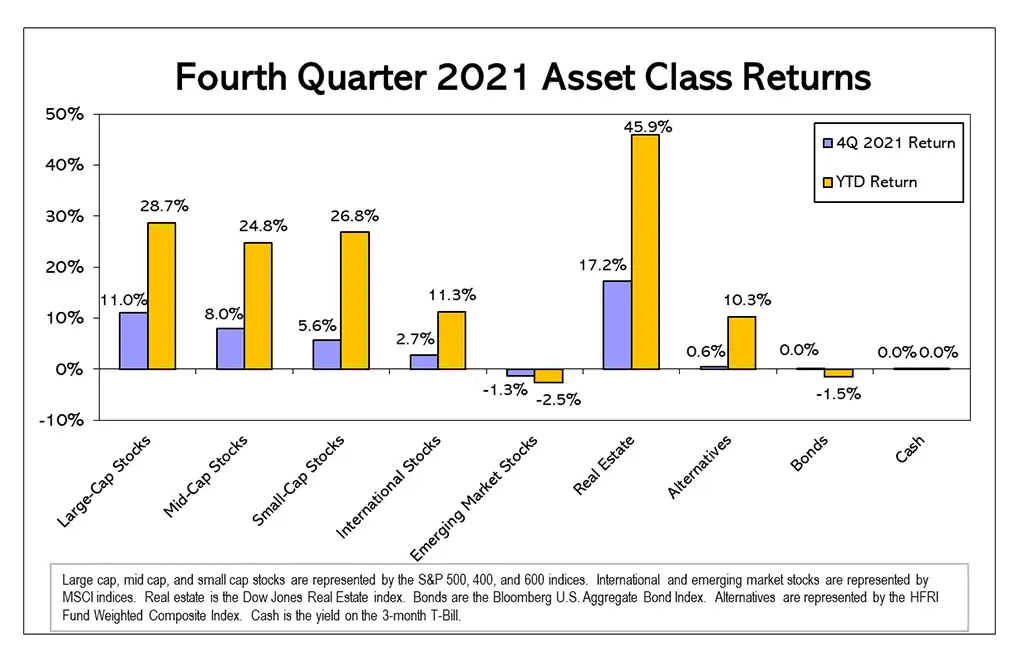
The fourth quarter of 2021 was a microcosm of 2021 as a whole. Many of the trends that we saw throughout the year continued into year end. The emergence of a new COVID variant contributed to reimposed restrictions, supply chains disruptions, and rising inflation. And, the stock market responded similarly to prior COVID scares: a knee-jerk reaction down followed immediately by a rally that culminated in new record highs. Other trends also continued as international stocks continued to trail their US counterparts despite more attractive valuation metrics, and bonds delivered another quarter of lackluster results.
MARKET LEADERSHIP SHIFTING
Within the US stock market, leadership started to shift to more defensive sectors. Energy stocks rebounded quite well in 2021 after an uninspiring 2020. Energy was the strongest performer of all US sectors with impressive returns of over 50% for the full year. This was caused by a rebound in travel and tighter oil supply that drove crude oil prices from around $50 per barrel at the beginning of the year to above $85 per barrel in October. Tight supply and low interest rates also spurred excellent returns for real estate, which was the second-best performing stock market sector. Rounding out value stock sectors, financials also performed well. However, technology stocks, which are characteristically growth stocks, were no slouch, gaining almost 35% for the full year. While value stocks staged a significant rebound and outperformed growth stocks to start the year, growth stocks outperformed to end the year. This has been the trend for many years now, leaving valuation disparities among value and growth historically wide.
All domestic stock market sectors generated double-digit returns this year, however, there were pockets of the market that were not as fortunate. Stay-at-home stocks were the primary casualties, with prior Wall Street darlings such as Zoom (ZM) and Peloton (PTON) falling 45% and 76%, respectively. In another sign of market sentiment shift, pockets of growth stocks, primarily for companies that were unprofitable, also underperformed late in the year compared to the overall market. That being said, notable tech giants such as Microsoft, Apple, and Alphabet all outperformed the S&P 500 this year, increasing the index’s concentration and valuation metrics to even higher levels.

4th Quarter 2021 Asset Class Returns
VOLATILITY AHEAD
The world seems to be in flux, and the stock market is behaving similarly, making economic and financial forecasts even more difficult than usual. Indeed, economic projections made last year for 2021 have not been entirely accurate. In December of 2020, the Fed forecasted a 4.2% increase in GDP and an unemployment rate of 5%, which represents fairly anemic growth assuming a rebound from an almost complete shutdown of the global economy. In fact, the recovery will likely end up stronger than previously anticipated, as GDP appears to have increased in the 5-6% range and the unemployment rate will be closer to 4%. Monetary and fiscal policy, particularly when based on mistaken forecasts, will almost certainly result in higher market volatility in the year to come
The downside to this strong growth, and the missed projections by policymakers, is that inflation is now running much hotter than expected. Last year’s forecast by the Fed of 2% inflation, using its preferred metric of the PCE deflator, is now over 5% and still rising. The result is that interest rate hikes will likely occur quicker than previously anticipated. Last December, only one Federal Open Market Committee (FOMC) participant expected an increase in the Fed Funds target rate in 2022, but after the latest meeting, all participants expect rate hikes in 2022, with the majority expecting the rate to be increased three times. This is not unique to the US, as the Bank of England and many other central banks have already raised short-term interest rates as a measure to curb inflationary pressures.
STABILIZING ASSETS
While bonds continued to struggle throughout 2021 on account of the low interest rate environment, our preferred alternative investments were generally able to deliver more attractive returns. Funds we use for private real estate, alternative lending, and style premia each delivered very impressive returns for the full year. Our multi-strategy fund saw modest gains as well. Managed futures and reinsurance funds were not as impressive, but full year performance of these funds was comparable to the overall bond market.
The exceptional returns in the stock market last year have caused some skepticism on future return projections, which we share. In a poll conducted by CNBC consisting of chief investment officers, equity strategists, and portfolio managers, inflation topped the list of what is worrying investors the most, followed by the Fed raising rates at the wrong time, and the economic impact of COVID. A full 80% of respondents believed the market would return less than 10% this year, with more investors anticipating flat or negative returns as opposed to returns above 10%. It is important to take these projections with a grain of salt. The big banks projected returns for the S&P 500 that fell in a range between 1% and 17% for 2021, all falling significantly short of the actual return of 28.7%. While current valuation levels suggest the market isn’t poised for another year of robust growth, nothing is certain. Whether the projections of muted returns in the near future come to fruition or not, maintaining a well-diversified portfolio remains important in mitigating downside risk in bear markets while still capturing adequate returns during bull markets.